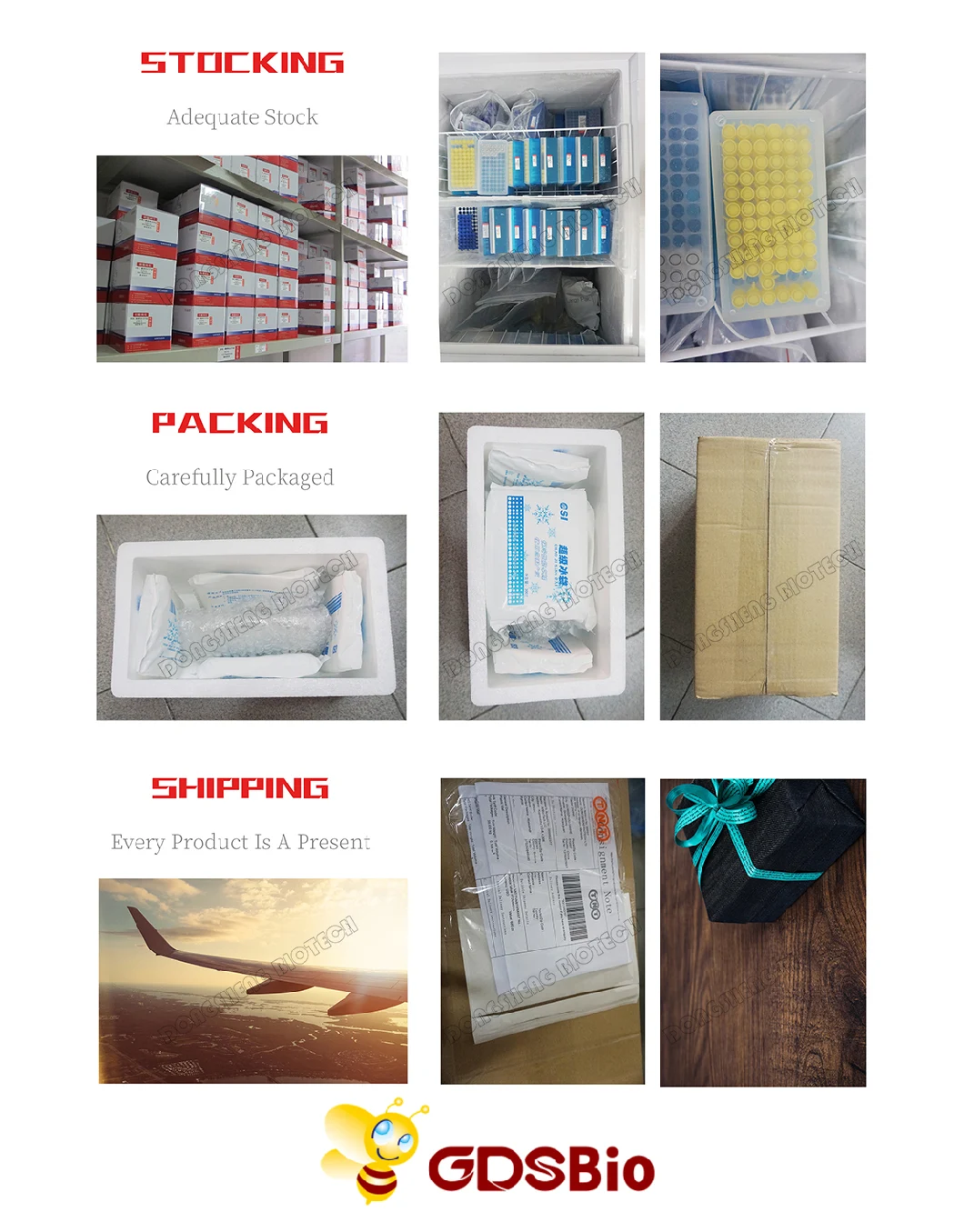cDNA Rt PCR Gold Reverse Transcriptase R3001 2000U R3002 10000U
Product Details:
| Place of Origin: | China |
| Brand Name: | GDSBio |
| Certification: | / |
| Model Number: | R3001/R3002 |
Payment & Shipping Terms:
| Minimum Order Quantity: | 1 bag |
|---|---|
| Packaging Details: | small package or bulk distribute or OEM |
| Delivery Time: | 8work days |
| Payment Terms: | L/C, D/A, D/P, T/T, Western Union, MoneyGram |
| Supply Ability: | 100 Bag/Bags Per Day |
|
Detail Information |
|||
| Cat. No.: | R3001/R3002 | Concentration: | R3001(2,000U) R3002(10,000U) |
|---|---|---|---|
| Appearance: | Colourless | Group: | Reverse Transcriptase PCR Reagents |
| Activity: | Pass | Amplification Capability: | / |
| Logo Printing: | With Logo Printing | Transport Package: | Packing |
| Production Capacity: | 100 Bag/Bags Per Day | Storage Conditions: | Store At -20°C |
| High Light: | R3001 Gold Reverse Transcriptase,2000U Gold Reverse Transcriptase |
||
Product Description
Gold Reverse Transcriptase R3001(2,000U) R3002(10,000U)
Gold Reverse Transcriptase
For research use only
Components
| Component | R3001 (2,000 U) | R3002 (10,000 U) |
| 5 × Gold Buffer | 100 μl | 500 μl |
| Gold Reverse Transcriptase (200 U/μl) | 10 μl | 50 μl |
Storage
This reagent should be kept at -30~15°C.
Description
Gold Reverse Transcriptase is a new reverse transcriptase obtained by in vitro molecular evolution based on M-MLV (RNase H-) Reverse Transcriptase. The first strand of cDNA can be synthesized at 37~55°C. Gold Reverse Transcriptase has further significantly improved sensitivity, specificity, thermal stability and half-life, which is very suitable for reverse transcription of RNA templates with complex secondary structure. Gold Reverse Transcriptase has stronger polymerization and extension ability, which can be used for the synthesis of long cDNA and the construction of high proportion of full-length cDNA library.
Unit Definition
Poly (rA)·Oligo (dT) was used as the template/primer. At 37°C for 10 min, the amount of enzyme required to add 1 nmol dTTP as an acid-insoluble substance was defined as 1 unit of activity (U).
Quality Control
Exonuclease residue detection: 200 U of this product and 50 pmol single-stranded DNA substrate were incubated at 37°C for 16 h, and the DNA electrophoresis band did not change after denaturation PAGE electrophoresis.
Detection of endonuclease residue: 200 U of this product and 0.3 μg of pBR322 DNA were incubated at 37°C for 4 h, and the electrophoresis bands of the plasmids were not changed by agarose gel electrophoresis.
RNase residue detection: the product of 200 U and 1 μg of 293 cell RNA were incubated at 37°C for 30 min, and the electrophoresis band of RNA was unchanged by agarose gel electrophoresis.
E.coli DNA residue detection: the nucleic acid residue in 60 U was detected by E. coli gDNA-specific TaqMan qPCR, and the residue of E. coli genome was less than 10 copies.
Functional detection 1: 200 U enzyme was added to the reverse transcription system, 1 μg HeLa cells total RNA was used as template, Oligo (dT)23 as primer, and the reaction was conducted at 50°C for 45 min.1/10 cDNA product was taken for PCR amplification of VIN gene. Agarose gel electrophoresis with EB staining showed a single 4.6 kb band.
Functional detection 2: 200 U enzyme was added to the reverse transcription system, 1 pg HeLa cell total RNA was used as template, Oligo (dT)23 as primer, and the reaction was conducted at 50°C for 30 min.1/10 cDNA product was taken for PCR amplification of GAPDH gene. Agarose gel electrophoresis with EB staining showed a single 550 bp band.
Functional detection 3: 500 ng HeLa cells total RNA as template, Oligo (dT)23VN as primer, 50°C reaction for 45 min.1/10 cDNA product was taken for PCR amplification of the Polε gene.Agarose gel electrophoresis, EB staining, a single 7.1 kb (gc-rich) band can be seen.
Matters Needing Attention
Prevent RNase contamination
Please keep the experimental area clean.Clean gloves and masks should be worn during operation. RNase-free shall be ensured for the centrifugal tubes, pipetting tips and other consumables used in the experiment.
Primers selection
The follow-up experiment is PCR
If the template is of eukaryotic origin, Oligo dT is generally preferred, paired with the 3 'Poly A tail of eukaryotic mRNA for maximum yield of full-length cDNA.
Gene specific primers (GSP) have the highest specificity.However, in some cases, the GSP used for PCR reaction cannot effectively guide the synthesis of the first strand of cDNA.At this point, the reverse transcription can be redone using Oligo dT or Random hexamers.
Random hexamers have the lowest specificity, and all RNA, including mRNA, rRNA, and tRNA, could be used as templates for Random hexamers.Random hexamers can be used as a primer when the target region has a complex secondary structure or a high GC content, or when the template is prokaryotic and the use of Oligo dT or gene-specific primers (GSP) cannot effectively guide cDNA synthesis.
The follow-up experiment is qPCR
Oligo dT mixed with Random hexamers resulted in the same cDNA synthesis efficiency in each region of the mRNA, helping to improve the authenticity and repeatability of the quantitative results.
![]()
![]()

Dongsheng Biotech offers different series of products to help you achieve PCR success. For enzymes, our Taq Polymerase, HS Taq DNA Polymerase, FS Taq DNA Polymerase, Pfu DNA Polymerase and Fusion Pfu DNA Polymerase provide high fidelity, efficient, sensitivity PCR performance. We also have Long Taq DNA Polymerase for long PCR performance.








